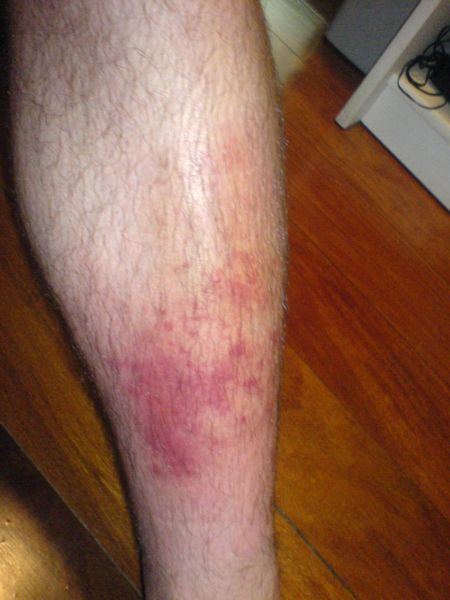Cellulitis
| Cellulitis | |
 | |
|---|---|
| Infected left shin |
|
Cellulitis Microchapters |
|
Diagnosis |
|---|
|
Treatment |
|
Case Studies |
|
Cellulitis On the Web |
|
American Roentgen Ray Society Images of Cellulitis |
For patient information click here
Editor-In-Chief: C. Michael Gibson, M.S., M.D. [1]; Associate Editor(s)-in-Chief: Aditya Govindvarjhulla, M.B.B.S.
Overview
Cellulitis is a spreading infection of the dermis and subcutaneous tissue secondary to any source of skin trauma or immunosuppression.
Pathophysiology
Microorganisms, most commonly Group A streptococcus and staphylococcus, enter the skin layers through previous cuts or trauma initiating an inflammatory response. This presents with redness, swelling, pain, and warmth. In the absence of immunocompetence, the infection may become systemic eventually leading to bacteremia.
In severe cases, the infection may spread to deeper tissue resulting in necrotizing fasciitis or 'flesh-eating disease' requiring immediate surgical evaluation.
Causes
The most common causative agents of cellulitis are Group A streptococcus and staphylococcus.
Differentiating Cellulitis from other Diseases
It is important to differentiate cellulitis from thrombophlebitis, contact dermatitis, drug reactions, and arthritis. Additionally, it should be differentiated from other causes of lower limb edema such as venous insufficiency and deep venous thrombosis.
Epidemiology and Demographics
Cellulitis is most frequently seen in middle-aged and older adults. It has an incidence of 200 per 100,000 patient-years with a higher incidence in males.
Risk Factors
The risk factors for cellulitis include, but are not limited to, the elderly, a weakened immune system, diabetes, HIV, prior history of cellulitis, varicose veins, skin disorders resulting in breaks in the skin, lymphedema, and hygiene.
Natural History, Complications and Prognosis
Trauma to the skin serves as an entry point for the bacteria, releasing toxins that produce an inflammatory response. This subsides with 7-10 days of antibiotic use. However, if not treated promptly with antibiotics, the disease spreads rapidly resulting in complications. These include sepsis, osteomyelitis, lymphangitis, endocarditis, meningitis, and gangrene.
Diagnosis
History and Symptoms | Physical Examination | Laboratory Findings | Chest X Ray | CT | MRI | Ultrasound | Other Diagnostic Studies
Treatment
Medical Therapy | Surgery | Primary Prevention | Secondary Prevention | Cost-Effectiveness of Therapy | Future or Investigational Therapies
Patients who require hospitalization for ICU admission, operating room surgical intervention, or death have one of the following six risk factors upon presentation[1]:
- abnormal cross-sectional imaging result ("air or gas, abscess or fluid collection, osteomyelitis, or suspicion of osteomyelitis")
- systemic inflammatory response syndrome
- previous infection at the same location
- infection involving the hand * diabetes* age >65 years
Case Studies
- ↑ Mower WR, Kadera SP, Rodriguez AD, Vanderkraan V, Krishna PK, Chiu E; et al. (2018). "Identification of Clinical Characteristics Associated With High-Level Care Among Patients With Skin and Soft Tissue Infections". Ann Emerg Med. doi:10.1016/j.annemergmed.2018.09.020. PMID 30420232.